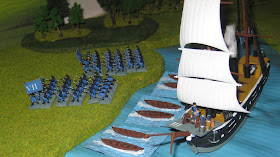Background
To play my VSF campaign between NSW and Victoria I needed a set of rules and I decided to write my own.
I wanted something relatively simple, of only a few pages
(similar to FUBAR) but which had enough rules for morale, machinery reliability
(from GASLIGHT) and also able to manage reasonably sized armies of toy soldiers.
I was not going to attempt to create a realistic set of
rules with lots of detail as these would be very long and time consuming both to write and to play.
To this end the rules represent many factors in a very limited fashion or
ignore them completely. Hopefully I still get some of the “flavour” of the
period they are set in.
I feel that reliability of machinery is important for this
era and it was something I wanted to include in the rules. However I do not want it ruining the game, if due to bad dice rolls, a machine can
just sit there all game doing nothing.
To cover unit morale and experience I decided to combine machine reliability with human training and morale for a
single “reliability” indicator that would cover them both.
As casualties or damage are taken reliability will decrease for
both troops and machinery. This is reflected by the decrease in reliability
levels during the game. Reliability effects the ability of units to carry out
actions and their effectiveness in combat and so is also a proxy for morale.
Action points were included to give some variability in
units’ reactions and to create some of Clausewitz’s friction or fog of war.
Each turn units will roll to see how many action points they get that turn and
then can spend them performing different actions.
Action point generation are biased to give each unit the
chance of acting each turn. High reliability / trained troops are likely to do
more than less reliable/trained troops and to ensure that troops will not stand around (staring at each other in embarrassment) both high and medium reliability troops will always do something.
Action points also give the opportunity for highly trained
undamaged units to out shoot less trained or battle damaged units as each turn
they are likely to fire more and with greater effect.
I also like the idea that when your troops are out of enemy
line of sight your troops can move further as this gives more reason to hold
reserves, switch attacks, etc. than if troops can only move the same distance all
the time. On a large enough board you can do flank marches with some (but not
complete) confidence that the troops will get there in time. To do this I have included
the ability to move multiple times if a unit is only in the enemy’s LOS for one
of the moves - as long as you get enough action points.
Multiple moves can give an attacker an advantage but only at the risk of an attack becoming disjointed as some troops move faster or more often than others.
Suppression is inspired by that in FUBAR where initial
losses are not permanent but can be recovered. Action points spent on removal
of suppression levels can represent damage control on machines or taking cover
for other troops. If the decision is to press on regardless of the damage or fire then the next casualties or damage will be more permanent.
The markers on the bases are to remove the need for
bookkeeping or having dice next to the figures, or in the case of FUBAR having
troops on their side. Using the blue, green, yellow and red bars as markers is
inspired from computer games where these indicators are common on screen.
I didn’t want any type of troop type to dominate the game so
I think they all have trade-offs and benefits. The practice battles seemed to go
the right way and to be reasonably balanced. The other side of troop types is
being able to represent everything but without having too many rules or special
cases. I think this has happened and the generic nature of the weaponry, saves
for damage, and the reliability factors mean that many things can be
represented within the rules.
Army Commanders were added to the rules simply because I had
painted and based them for each of my armies. The rules give them the ability
to affect the battle, to “rally” troops and get them to do more, but only in a
limited area. These abilities seems to be consistent with the role of
commanders in a battle.
The rules have turned out to be fairly “bloody” and combat
and unit destruction is fairly quick. I think that this makes a better game
(though not very realistic).
Combat is also biased towards the unit that fires first and
in a fair fight, the unit that fires first will win. However, this seems to
conform to reality and just proves that when attacking you need to concentrate
against defenders with at least double the forces.





































